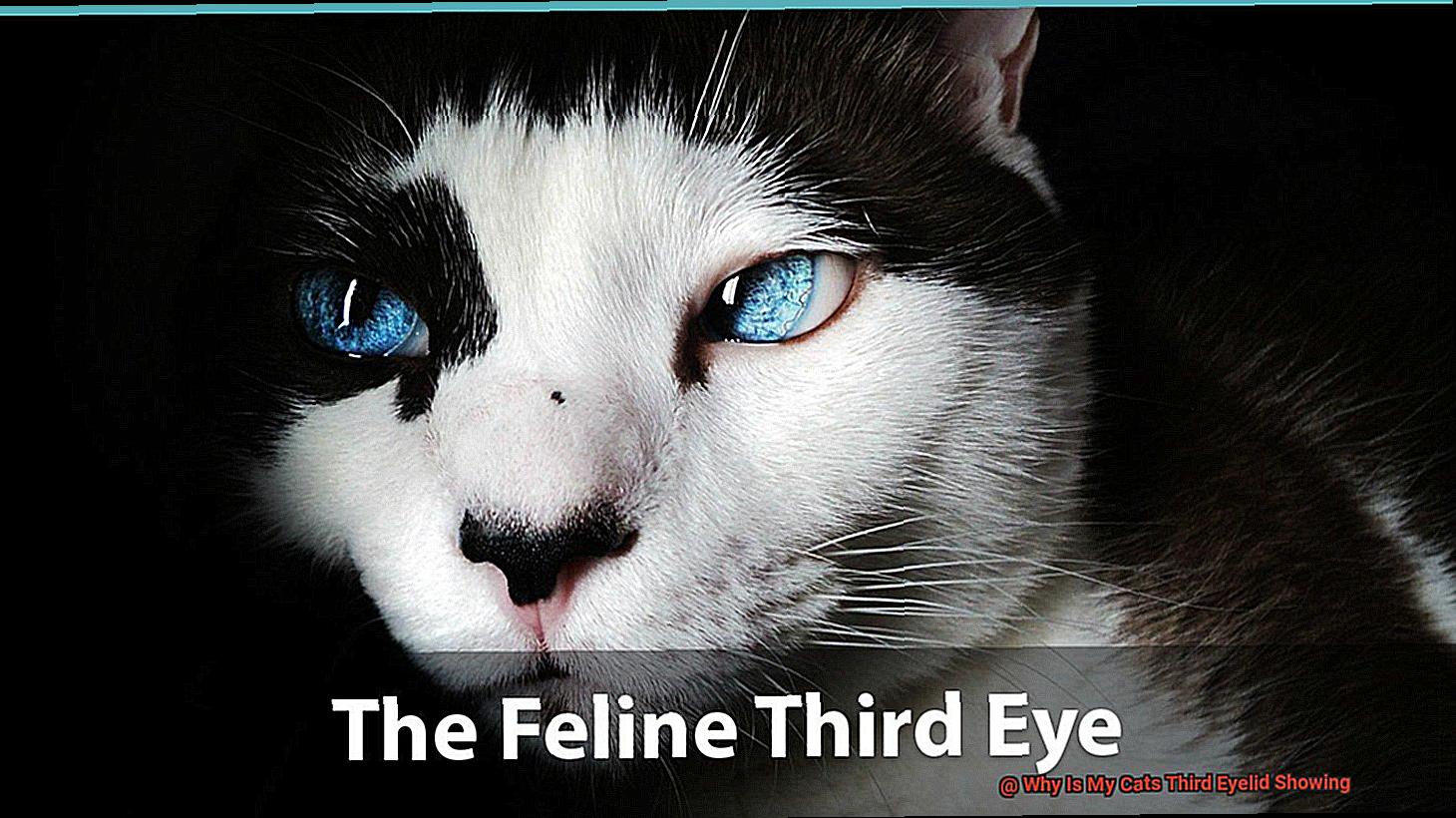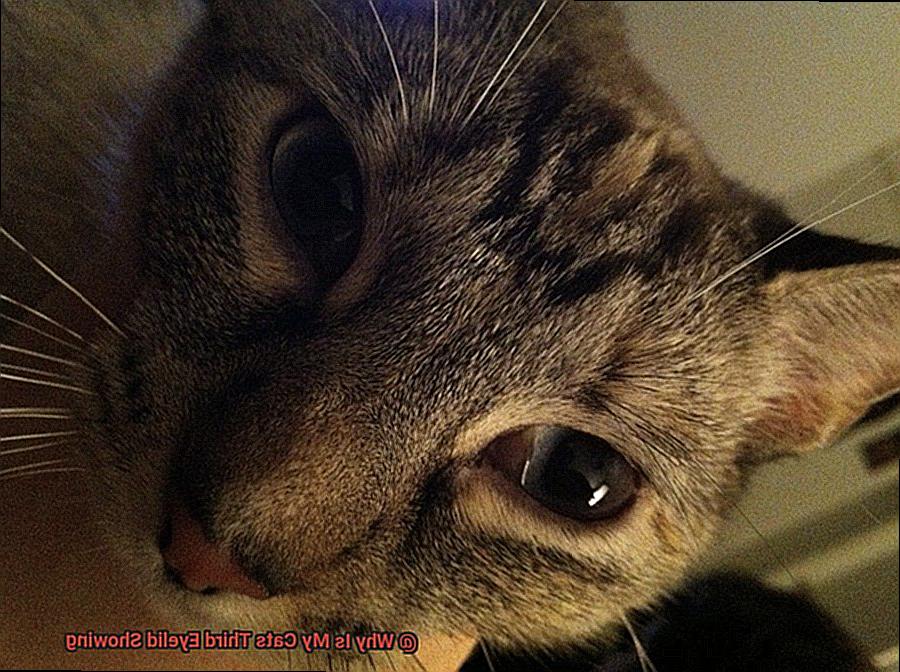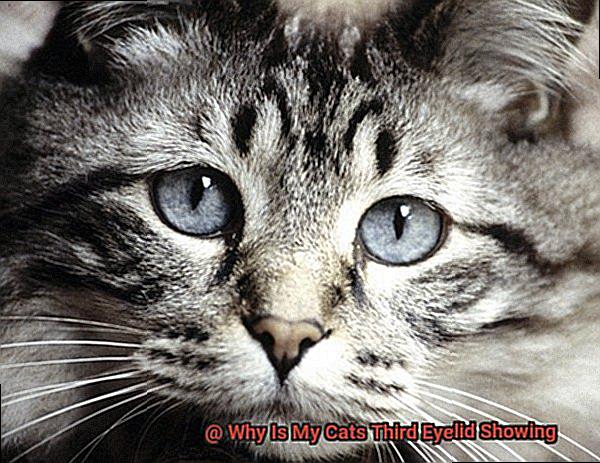Have you ever glanced at your feline friend and noticed their third eyelid showing?
It can be a bit disconcerting, but don’t worry – it’s actually a natural occurrence that happens frequently in cats. The third eyelid, also known as the nictitating membrane, is a thin layer of tissue that helps protect and lubricate the eye.
Normally unseen, its appearance can indicate different things happening with your furry companion. So why is your cat’s third eyelid showing?
There are several reasons why this may occur. It could be due to an injury or irritation to the eye, an infection, or even a sign of an underlying health issue.
It may also be a reflexive response to bright lights or sudden movements. As pet owners, it’s crucial to understand the various reasons why your cat’s third eyelid may appear to ensure their comfort and well-being.

In this blog post, we’ll explore the reasons behind your cat’s third eyelid showing and what actions you should take.
We’ll also discuss how to recognize signs of discomfort or infection and provide tips on how to care for your feline friend’s eyes properly.
What is a Third Eyelid?
That’s the third eyelid, also known as the nictitating membrane or haw.
Unlike our eyelids that move up and down, the third eyelid moves diagonally across the eye to protect and lubricate it. This natural windshield wiper is a crucial component of your cat’s immune system.
It contains lymphoid tissue that produces antibodies to help fight off infections. In fact, cats have a well-developed third eyelid compared to other animals because they are predators and need extra protection while hunting or fighting.
The membrane can rapidly move across the eye to shield it from scratches or damage. But the third eyelid’s primary function is to keep the eye moistened and clean by spreading tears across the surface.
It acts as a natural defense mechanism against foreign particles and debris, ensuring optimal ocular health. However, if you notice that your cat’s third eyelid is showing excessively or for an extended period, it could be an indication of an underlying health issue.
This may include viral infections, allergies, neurological issues, or trauma. If this symptom persists, it is essential to consult with a veterinarian immediately to rule out any serious health concerns.
It’s also important to note that certain breeds such as Siamese and Burmese cats are predisposed to having a visible third eyelid due to genetics. So don’t fret if you notice that your cat’s third eyelid is becoming more prominent.
Monitor their behavior and contact your veterinarian if any other concerning symptoms accompany this change. In summary, the third eyelid plays an indispensable role in maintaining your cat’s ocular health and immune system.
While a visible third eyelid is common in cats, prolonged or excessive showing could indicate a health issue.
Causes of Visible Third Eyelids in Cats
There are several reasons why this might occur, and understanding these causes is crucial to addressing the issue effectively.
One common cause of a visible third eyelid in cats is illness or injury. When a cat is sick or injured, their body may produce more mucus and fluids than usual, which can cause the third eyelid to become more prominent.
Additionally, certain illnesses such as upper respiratory infections can result in swelling and inflammation around the eyes, leading to a noticeable third eyelid. Dehydration is another potential culprit.
When a cat becomes dehydrated, their body conserves moisture by producing fewer tears and other fluids. As a result, the third eyelid may move across the eye more often to protect it from further damage, making it more visible.

In some cases, a visible third eyelid may be a sign of an underlying medical condition such as feline leukemia or kidney disease. These conditions can compromise a cat’s immune system and overall health, leading to various symptoms such as a visible third eyelid.
Lastly, certain medications or treatments may cause the third eyelid to become more visible temporarily. For example, some anesthetics and sedatives can cause the third eyelid to protrude while the drug is in effect.
Dehydration as a Cause for Visible Third Eyelids
Dehydration occurs when your cat’s body tries to hold onto fluids by retaining them in different areas. One of these areas is the third eyelid, which can cause it to protrude more than usual.
This can give the impression that your cat is having an eye problem, but in reality, it’s just a symptom of dehydration. There are several reasons why a cat can become dehydrated, including not drinking enough water, vomiting, diarrhea or underlying medical conditions such as kidney disease.
It’s essential to monitor your cat’s water intake and ensure they are drinking enough throughout the day. If you notice that your cat isn’t drinking much water, try offering them wet food or adding water to their dry food.
If you suspect your cat is dehydrated, don’t wait; take action immediately. Offer fresh water and encourage them to drink.
Monitor their behavior closely and keep them under observation. In severe cases of dehydration, your cat may require veterinary care.
Remember, hydration is key when it comes to preventing visible third eyelids in cats.
Genetic Predisposition to Visible Third Eyelids
Certain breeds such as Burmese and Siamese cats have a higher likelihood of developing visible third eyelids due to their flatter face structure. But that’s not all – cats with larger eyes tend to have more visible third eyelids.
This is because the third eyelid serves as a natural protective mechanism for the eye, and cats with bigger eyes require more protection. Furthermore, cats with white or albino fur may also be at a higher risk of developing visible third eyelids due to the lack of pigmentation in their eyes.

While genetic predisposition cannot be prevented or cured, it is essential for cat owners to be aware of this factor and keep a close eye on their feline’s eye health.
If you notice your cat’s third eyelid becoming suddenly visible or remaining visible for an extended period, it is best to consult with a veterinarian to rule out any underlying health concerns.
So, show them some extra love and care by monitoring their eye health regularly.
Symptoms to Look Out For When Your Cat’s Third Eyelid Is Showing
Sometimes things can go awry, and you might notice that your cat’s third eyelid is showing.
Although this is a natural protective mechanism for some cats, it can also be a warning sign of an underlying health problem. Here are seven symptoms to keep an eye on when your cat’s third eyelid is showing:
- Firstly, redness or swelling in your cat’s eye could be a sign of an injury or infection. It’s essential to take a closer look to determine the underlying cause.
- Secondly, if you notice any discharge coming from your cat’s eye, it could be a sign of conjunctivitis or another eye infection.
- Thirdly, frequent squinting or blinking could indicate pain or discomfort.
- Fourthly, changes in appetite could be a warning sign of an underlying health issue. If your cat isn’t eating as much as they usually do, it’s time to take note.
- Fifthly, lethargy or decreased activity levels could also be cause for concern. If your normally active cat seems to lack energy, investigate further.
- Sixthly, watch for changes in behavior. If your cat starts acting differently than usual, it could indicate pain or discomfort.
- Lastly, excessive tearing is often a sign of an eye infection or injury. If you notice any of these symptoms in your cat, take them to the vet as soon as possible.

Treatment Options for Visible Third Eyelids in Cats
When you notice that their third eyelid is showing, it can be quite concerning.
This could be an indication of an underlying health condition, and it’s vital to seek veterinary care for proper diagnosis and treatment. But what are the treatment options available for visible third eyelids in cats?
One option is medication. Depending on the underlying cause of the issue, your veterinarian may prescribe antibiotics or anti-inflammatory medication to alleviate symptoms and improve overall health.
Just like how a hot cup of tea can soothe a sore throat, medication helps to relieve symptoms and make your kitty feel better. In some cases, surgery may be necessary to correct the issue.
This is especially true if the visible third eyelid is caused by a prolapsed gland of the nictitating membrane. During this procedure, the prolapsed gland is surgically repositioned and sutured back into place.
Think of it like repairing a faulty machine; surgery can help to correct the issue and restore proper function. Supportive care is another treatment option for visible third eyelids in cats.
This involves providing a comfortable and stress-free environment for your cat to recover in. Your veterinarian may also recommend eye drops or ointments to soothe any irritation or discomfort associated with the visible third eyelid.
Imagine snuggling up in your favorite blanket with a cup of warm cocoa when you’re feeling down; supportive care can help your kitty feel more comfortable and cared for.
It’s important to note that treatment options for visible third eyelids in cats will vary depending on the underlying cause of the issue.
Prevention of Visible Third Eyelids in Cats
One of the things that can cause concern is when you notice their third eyelid becoming visible.
However, the good news is that there are simple steps you can take to prevent this issue! First and foremost, hydration is key.
Dehydration is one of the primary reasons why a cat’s third eyelid becomes visible. Providing clean and fresh water to your cat is essential in preventing this problem.
Make sure you check their water bowl regularly and refill it as needed. Another effective preventative measure is keeping your cat’s eyes clean.
By wiping their eyes gently with a damp cloth or using a specially formulated eye cleaner recommended by your vet, you can prevent irritation and infections that may cause the third eyelid to show. Regular grooming around the eyes can also help keep them clean and healthy.
Nutrition also plays a crucial role in preventing visible third eyelids in cats. Feeding them a balanced diet with essential vitamins and minerals can help prevent eye infections and other health issues that may lead to the appearance of the third eyelid.
Speak to your vet about what type of food is best for your cat’s specific needs.
Reducing stress levels in your cat can also make a significant difference in preventing the third eyelid from showing.
Stress can weaken their immune system, making them more susceptible to infections and other health issues that may cause the third eyelid to become visible. Providing plenty of playtime, exercise, and affection can all help reduce your cat’s stress levels.
Lastly, regular visits to the vet are imperative in preventing any health issues that may cause the third eyelid to show. A vet can detect and treat any underlying health problems early on, preventing further complications and ensuring your cat remains healthy and happy.
Conclusion
To sum up, seeing your cat’s third eyelid is normal and serves a crucial purpose in protecting their eyes.
However, if it persists for an extended period or appears excessively, it may be a sign of an underlying health issue. As a responsible pet owner, it’s vital to understand the various reasons why your cat’s third eyelid may appear and take prompt action.
If you notice any symptoms such as redness, swelling, discharge, or changes in appetite or behavior, seek veterinary attention immediately. Early detection and treatment are essential for ensuring your cat’s health and well-being.
Fortunately, there are several treatment options available for visible third eyelids in cats. These include medication, surgery, supportive care such as providing a comfortable environment for recovery and using eye drops or ointments to soothe any irritation.
Prevention is always better than cure. To prevent visible third eyelids from occurring in the first place, ensure that your cat has access to clean and fresh water at all times to prevent dehydration.
Regular grooming and wiping their eyes with a damp cloth or using a specially formulated eye cleaner recommended by your vet can also help keep their eyes clean. Feeding them a balanced diet rich in essential vitamins and minerals can help prevent eye infections while reducing stress levels through playtime, exercise, affection can reduce susceptibility to infections.
By following these simple but effective steps, you can ensure that your furry friend maintains good health and well-being.







